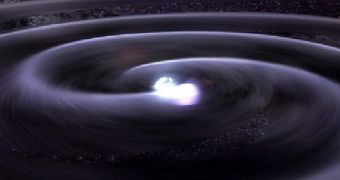A team of experts from the University of Washington in Seattle, led by physicists Ethan Kruse and Eric Agol, was recently able to use data collected by the NASA Kepler planet-hunting telescope to detect a self-lensing effect in a binary star system. This phenomenon was first proposed around 40 years ago, but it has never been actually observed directly until now.
The discovery was made as the team was analyzing a binary star located in the constellation Lyra, some 2,600 light-years away from Earth. This system has been known for some time, but many astronomers believed that the Sun-like star at its center was accompanied by an extrasolar planet. The latest study has revealed that the star's companion was, in fact, a white dwarf.
White dwarfs are the burnt-out cores of former Sun-like stars, which fuse helium into heavier elements, rather than hydrogen isotopes into helium. Our own parent star will reach this stage as well, after it finishes its hydrogen supplies, in about 4 to 5 billion years. Usually, white dwarfs are much smaller, more compact, and less bright than both yellow and red dwarf-class stars.
Due to their reduced dimensions and the distances involved, astronomers had a hard time determining the exact nature of the Sun-like star's companion. Kepler observations successfully solved the mystery, revealing that the companion was, in fact, a small star, not an exoplanet. This enabled the team to establish that the newly-identified object acted like a lens in space, Nature News reports.
Famed physicist Albert Einstein first proposed a phenomenon called gravitational lensing in 1915. His theory held that massive objects in space can distort spacetime around them through their intense gravitational pulls. Therefore, when a large object would pass between Earth and a more distant star, the light emitted by the latter would be amplified and bent (or lensed) as it passed by the former.
Gravitational lensing was confirmed long ago and is now a standard method of surveying galaxies and clusters located in the early Universe. Nearly four decades ago, astrophysicists predicted that a similar lensing effect, but on a smaller scale, would occur in binary systems. Called the self-lensing effect, this phenomenon would occur when one of the stars would pass in front of the other, as seen from Earth.
This is precisely what Kruse, Agol, and their colleagues discovered while analyzing the Kepler Object of Interest (KOI) 3278 binary system. The companion to the Sun-like main star passes between the latter and Earth once every 88 days, causing a 0.1 percent increase in the background star's brightness.
In a paper published in the April 17 issue of the top journal Science, the team says that this is the first time when this self-lensing effect has been observed directly in a binary system. “It was not till Kepler was launched that we had a telescope capable of finding such tiny changes” in brightness, Kruse says.

 14 DAY TRIAL //
14 DAY TRIAL //